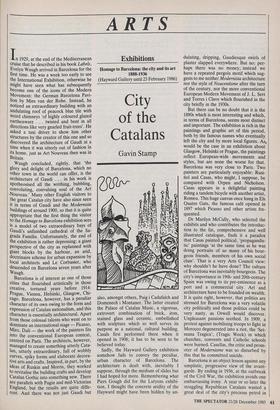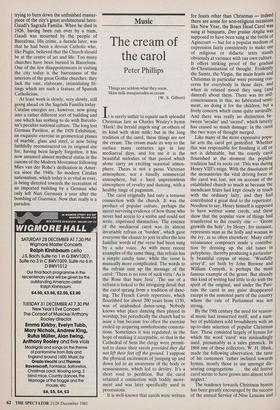ARTS
Exhibitions
Homage to Barcelona: the city and its art 1888-1936 (Hayward Gallery until 23 February 1986)
City of the Catalans
Gavin Stamp
In 1929, at the end of the Mediterranean cruise that he described in his book Labels, Evelyn Waugh arrived in Barcelona for the first time. He was a week too early to see the International Exhibition, otherwise he might have seen what has subsequently become one of the icons of the Modern Movement: the German Barcelona Pavi- lion by Mies van der Rohe. Instead, he noticed an extraordinary building with an undulating roof of peacock blue tile with weird chimneys 'of highly coloured glazed earthenware . . . twisted and bent in all directions like very gnarled fruit-trees'. He asked a taxi driver to show him other structures by the creator of this one and so discovered the architecture of Gaudi at a time when it was utterly out of fashion in its home, just as Art Nouveau then was in Britain.
Waugh concluded, rightly, that 'the glory and delight of Barcelona, which no other town in the world can offer, is the architecture of Gaudi . . . in his work is apotheosised all the writhing, bubbling, convoluting, convulsing soul of the Art Nouveau.' Many other English visitors to the great Catalan city have also since seen it in terms of Gaudi and the Modernista buildings of around 1900, so that it is quite appropriate that the first thing the visitor to the Homage to Barcelona exhibition sees is a model of two extraordinary bays of Gaudi's unfinished cathedral of the Sa- grada Familia. Unfortunately, the end of the exhibition is rather depressing: a giant perspective of the city as replanned with giant blocks by the harbour, an arid, doctrinaire scheme for urban expansion by local architects and Le Corbusier, who descended on Barcelona seven years after Waugh. Barcelona is of interest as one of those cities that flourished artistically in those creative, tortured years before 1914: Prague, Vienna, Helsinki, Glasgow, Chi- cago. Barcelona, however, has a peculiar character of its own owing to the form and expression of Catalan nationalism, and this character is essentially architectural. Apart from those colossal talents who went on to dominate an international stage — Picasso, Miro, Dali — the work of the painters fits into the conventional European context, centred on Paris. The architects, however, managed to create something utterly Cata- lan, utterly extraordinary, full of wobbly curves, spiky forms and elaborate decora- tive arts and crafts. Inspired, in part, by the ideas of Ruskin and Morris, they worked to revitalise the building crafts and develop Catalan Gothic into something new. There are parallels with Pugin and mid-Victorian England, but the results are quite diffe- rent. And there was not just Gaudi but also, amongst others, Puig i Cadafalch and Domenech i Montaner. The latter created the Palace of Catalan Music, a vigorous, extrovert combination of brick, iron, stained glass and ceramic, embellished with sculpture which so well serves its purpose as a national, cultural building. Casals first performed there when it opened in 1908; it has to be seen to be believed today, Sadly, the Hayward Gallery exhibition somehow fails to convey the peculiar, urban character of Barcelona. The architecture is dealt with, inevitably I suppose, through the medium of slides but I had hoped for more. Remembering what Piers Gough did for the Lutyens exhibi- tion, I thought the concrete aridity of the Hayward might have been hidden by un- dulating, dripping, Gaudiesque swirls of plaster slapped everywhere. But no: per- haps there was no money; instead we have a repeated pergola motif which sug- gests to me neither Modernista architecture nor the style of Noucentisme after the turn of the century, nor the more conventional European Modern Movement of J. L. Sert and Torres i Clave which flourished in the city briefly in the 1930s.
But there can be no doubt that it is the 1890s which is most interesting and which, in terms of Barcelona, seems most distinct and important. The exhibition is rich in the paintings and graphic art of this period, both by the famous names who eventually left the city and by more local figures. As, would be the case in an exhibition about Glasgow, Helsinki or Prague, the paintings reflect European-wide movements and styles, but are none the worse for that. Barcelona was very close to Paris. Two painters are particularly enjoyable: Rusi- nol and Casas, who might, I suppose, be compared with Orpen and Nicholson. Casas appears in a delightful painting riding a tandem bicycle with another artist, Romeu. This huge canvas once hung in Els Quatre Gats, the famous café opened in 1897 which Picasso and other artists fre- quented.
Dr Marilyn McCully, who selected the exhibits and who contributes the introduc- tion to the fat, comprehensive and well illustrated catalogue, finds it a paradox that Casas painted political, 'propagandis- tic' paintings 'at the same time as he was doing portraits of so many of his bour- geois friends, members of his own social class'. That is a very Arts Council view: why shouldn't he have done? The culture of Barcelona was inevitably bourgeois. The city's importance in 19th- and 20th-century Spain was owing to its pre-eminence as a port and a commercial city. Art and architecture have to be founded on wealth. It is quite right, however, that politics are stressed for Barcelona was a very volatile city politically and those politics could be very nasty, as Orwell would discover. Unpleasant passions seethed. In 1909, a protest against mobilising troops to fight in Morocco degenerated into a riot, the 'Set- mana Tragica', (Tragic Week) in which churches, convents and Catholic schools were burned. Casellas, the critic and prom- oter of Modernisme was so disturbed by this that he committed suicide.
Barcelona is an object lesson against any simplistic, progressive view of the avant- garde. By ending in 1936, at the outbreak of the Civil War, the exhibition avoids one embarrassing irony. A year or so later the struggling Republican Catalans wasted a great deal of the city's precious petrol in trying to burn down the unfinished master- piece of the city's great architectural hero: Gaudi's Sagrada Familia. When he died in 1926, having been run over by a tram, Gaudi was mourned by the people of Barcelona. His crime, a decade later, was that he had been a devout Catholic who, like Pugin, believed that the Church should be at the centre of art and life. Too many churches have been burned in Barcelona. One of the few disappointments in visiting the city today is the barrenness of the interiors of the great Gothic churches: they lack the vast, elaborate, intimidating fit- tings which are such a feature of Spanish Catholicism.
At least work is slowly, very slowly, still going ahead on the Sagrada Familia today. Catalan energies are, however, now going into a rather different sort of building and one which has nothing to do with Barcelo- na's peculiar national culture. The long lost German Pavilion, at the 1929 Exhibition, an exquisite exercise in geometrical planes of marble, glass and steel, is now being faithfully reconstructed on its original site for, having been largely forgotten, it has now assumed almost mythical status in the canons of the Modern Movement following Mies van der Rohe's deification in Amer- ica since the 1940s. So modern Catalan nationalism, which today is as vital as ever, is being directed towards the recreation of an imported building by a German who only left Nazi Germany a year after the bombing of Guernica. Now that really is a paradox.



















































































 Previous page
Previous page